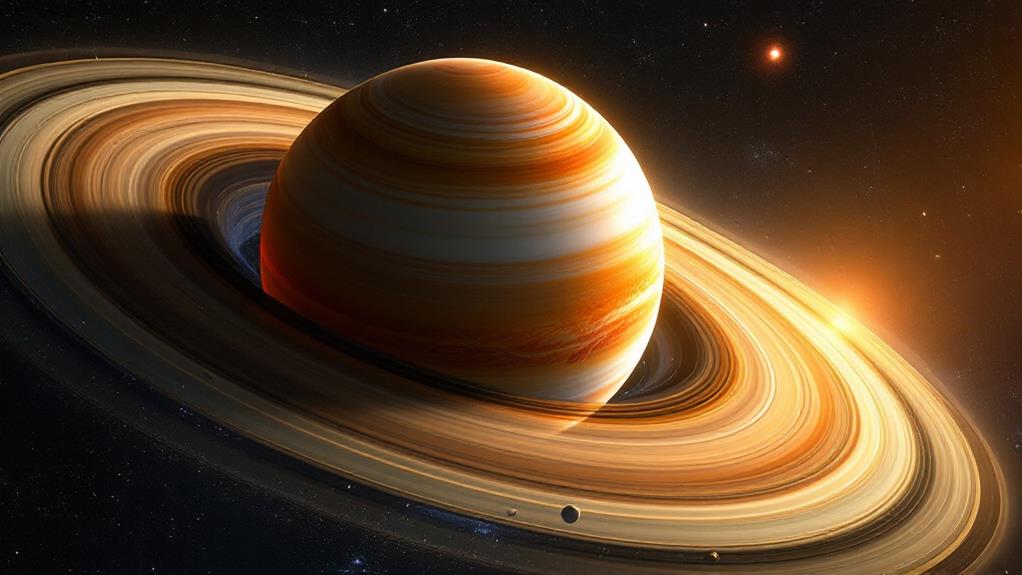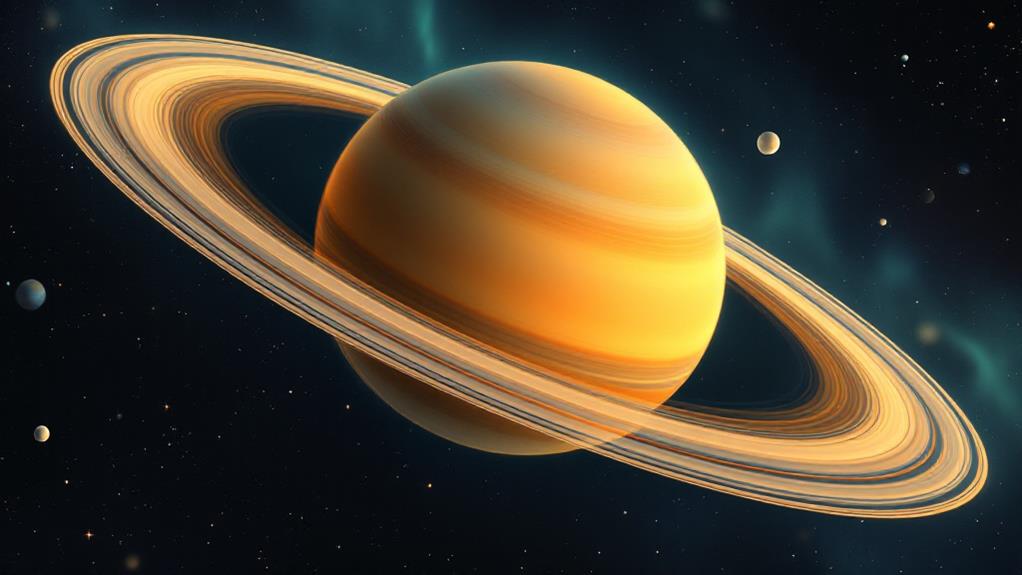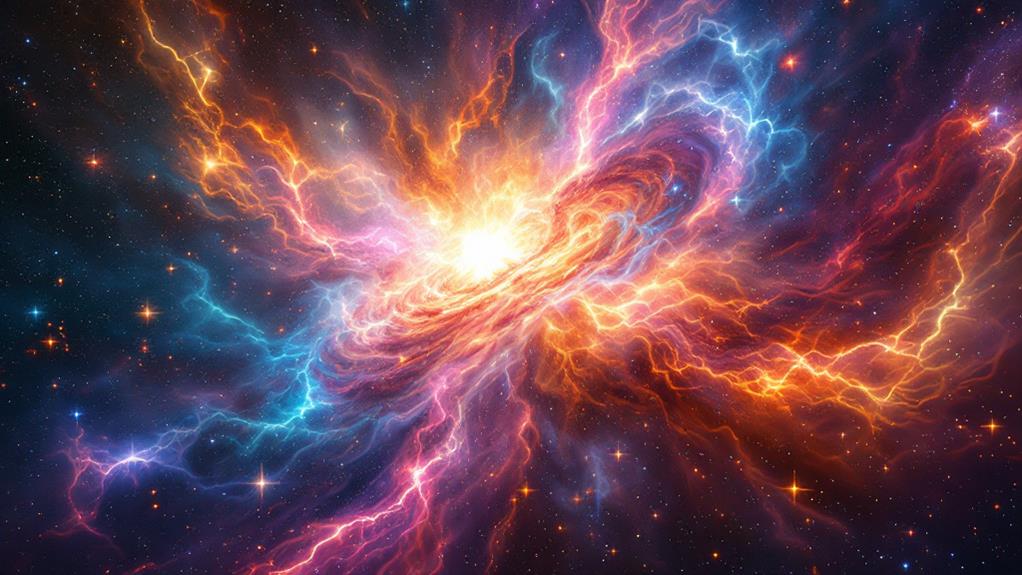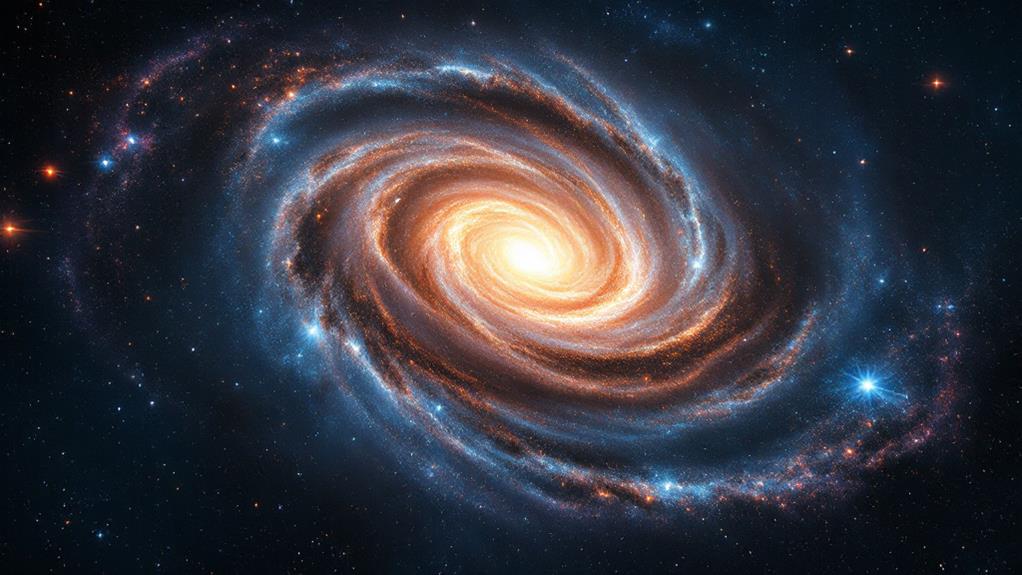Fascinating Facts About Uranus: the Ice Giant With a Tilt
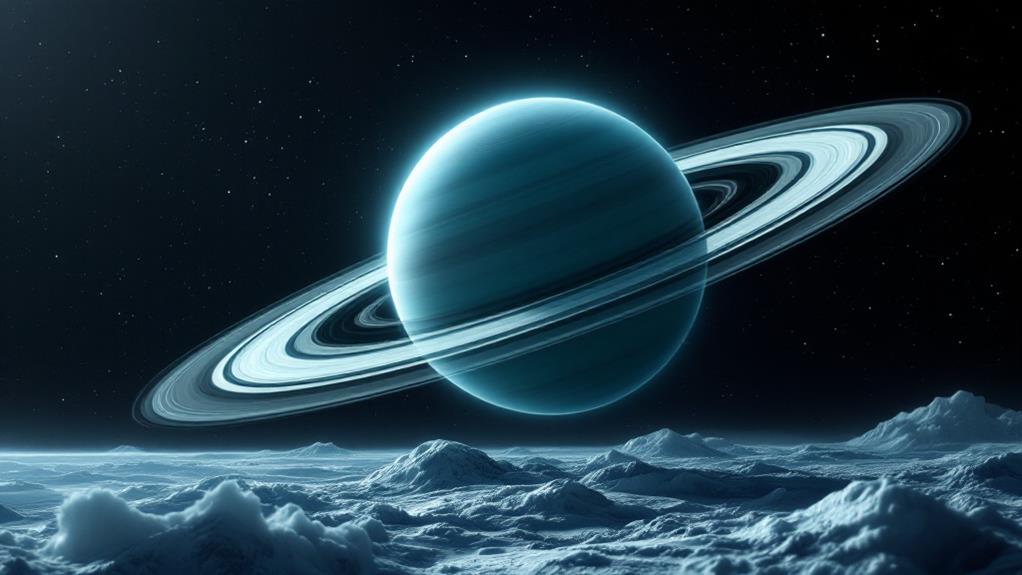
Uranus, the ice giant with a tilt, boasts a wealth of fascinating features. You'll find its extreme axial tilt of 98 degrees creates unique 42-year-long seasons. Its blue-green hue stems from methane-rich atmosphere absorbing red light. Uranus sports a complex ring system and 27 known moons, each with distinct characteristics. The planet's frigid atmosphere plummets to -224°C, making it the coldest in our solar system. Its unusual magnetic field, tilted at 59 degrees, causes dramatic seasonal changes. Identified in 1781 by William Herschel, Uranus continues to intrigue scientists with its potential for groundbreaking revelations. Exploring this tilted world uncovers a universe of intriguing facts.
Extreme Axial Tilt
With an axial tilt of about 98 degrees, Uranus spins almost completely on its side. This dramatic rotational axis sets it apart from other planets in our solar system, giving it some of the most unexpected orbital characteristics you'll find.
You might imagine Uranus rolling along its orbital path like a ball, rather than spinning upright like a top. This extreme tilt means that one pole faces the Sun for 42 years of continuous daylight, while the other experiences 42 years of darkness. As Uranus completes its 84-year orbit around the Sun, the poles gradually switch places.
The planet's unusual orientation also affects its seasons. Instead of having four distinct seasons like Earth, Uranus fundamentally has two seasons: a long summer and a long winter, each lasting about 42 years. During these periods, one hemisphere is bathed in sunlight while the other is plunged into darkness.
Scientists believe Uranus's extreme axial tilt may have been caused by a massive collision with another celestial body early in its history. This impact likely knocked the planet off its original axis, resulting in its current, highly tilted orientation.
Unique Blue-Green Appearance
Uranus's unusual tilt isn't its only distinctive feature. The planet's unique blue-green appearance sets it apart from its celestial neighbors, enthralling astronomers and space enthusiasts alike. This intriguing coloration is primarily due to the composition of its atmosphere, which is rich in methane gas.
When sunlight penetrates Uranus's atmosphere, the methane absorbs red light while reflecting blue and green wavelengths back into space. This selective absorption and reflection process creates the planet's distinctive atmospheric hues. You'll notice that Uranus appears as a pale blue-green orb when viewed through powerful telescopes or in high-resolution images captured by space probes.
Unlike Jupiter and Saturn, which display prominent bands and swirling storms, Uranus's atmosphere often appears relatively featureless. However, advanced imaging techniques have revealed subtle intriguing coloration patterns, including faint cloud structures and occasional bright spots. These features become more visible during Uranian equinoxes when the planet's poles are exposed to sunlight.
The unique blue-green appearance of Uranus serves as an embodiment of the diverse and fascinating nature of our solar system's planets, each with its own distinct characteristics and atmospheric compositions.
Complex Ring System

Complexity defines the ring system encircling Uranus. Unlike the prominent rings of Saturn, Uranus's rings are faint and narrow, making them challenging to observe from Earth. You'll find that these rings are composed of dark particles, ranging from dust-sized grains to larger chunks of rock and ice.
The planet's unusual axial tilt plays a significant role in shaping its ring system. As Uranus rotates on its side, the rings appear to be oriented vertically when viewed from Earth. This unique configuration affects how sunlight interacts with the rings, creating interesting patterns of light and shadow.
13 distinct rings identified
The outermost ring, called the ε (epsilon) ring, is the brightest
Some rings are thought to be shepherded by small moons
The rings are believed to be relatively young, possibly formed from the debris of shattered moons
Uranus's complex magnetic field also influences its ring system. The field's interaction with charged particles in the rings creates an ever-changing environment, potentially affecting the distribution and behavior of ring particles. As you investigate Uranus's rings, you'll uncover a fascinating interplay between the planet's unique characteristics and its surrounding ring system.
Diverse Moon Collection
Beyond its rings, Uranus boasts an impressive collection of moons. You'll find 27 known natural satellites orbiting this ice giant, each with its own unique characteristics. This extensive moon system showcases a diverse moon composition, ranging from small, irregularly shaped bodies to larger, spherical worlds.
The five largest moons of Uranus - Miranda, Ariel, Umbriel, Titania, and Oberon - are particularly fascinating. Miranda, the innermost of these, features a bizarre patchwork surface with canyons, cliffs, and terraced layers. Ariel and Umbriel present contrasting appearances, with Ariel showing signs of geological activity and Umbriel appearing darker and more heavily cratered. Titania and Oberon, the largest Uranian moons, possess a mix of impact craters and fault systems.
Uranus's smaller moons are equally intriguing. Some are thought to be captured asteroids, while others may have formed from the debris of larger moons that collided in the planet's past. These moons play pivotal roles in shaping Uranus's ring system and contribute to the planet's complex gravitational fluctuations.
Frigid Atmospheric Composition

The atmosphere of Uranus stands out as one of the coldest in our solar system, with temperatures plummeting to a frigid -224°C (-371°F) in its upper layers. This ice giant's frigid temperature profile is due to its unique composition and distance from the Sun. You'll find that Uranus' atmosphere consists primarily of hydrogen and helium, with traces of methane, water, and ammonia.
The layered cloud composition of Uranus creates a distinct structure:
- Upper layer: Methane ice crystals
- Middle layer: Ammonium hydrosulfide and water ice
- Lower layer: Ammonia and water droplets
As you explore deeper into Uranus' atmosphere, you'll encounter increasing pressure and temperature. The planet's interior is believed to contain a small rocky core surrounded by an icy mantle. This unique structure contributes to Uranus' overall frigid nature and distinctive blue-green appearance.
Interestingly, Uranus lacks a significant internal heat source, unlike other gas giants in our solar system. This absence results in a more uniform temperature distribution throughout its atmosphere, making it an intriguing subject for planetary scientists studying atmospheric patterns and composition in extreme conditions.
Unusual Magnetic Field
Uranus' magnetic field oddity sets it apart from other planets in our solar system. Unlike Earth's magnetic field, which aligns closely with its rotational axis, Uranus' magnetic field is tilted at a staggering 59-degree angle. This misalignment causes the magnetic poles to be located far from the geographic poles, resulting in a complex magnetic field structure that's constantly shifting as the planet rotates.
You might wonder what causes this unusual configuration. Scientists believe it's due to an unusual dynamo process within the planet's interior. Uranus' magnetic field is likely generated in a thin shell of electrically conducting fluid, rather than a solid core like Earth's. This unique arrangement leads to a more unstable and unpredictable magnetic field.
The consequences of this tilted magnetic field are fascinating. As Uranus orbits the Sun, its magnetic poles alternately point towards and away from the Sun, causing dramatic seasonal changes in the planet's magnetosphere. This variable environment affects how Uranus interacts with the solar wind and creates aurora displays that are unlike any other in our solar system.
Sideways Seasons

Occasionally, you might hear about unusual weather on Earth, but Uranus takes the concept of extreme seasons to a whole new level. Due to its unique rotational orientation, tilted at a staggering 98 degrees, Uranus experiences seasons unlike any other planet in our solar system.
This extreme tilt means that for nearly a quarter of its 84-year orbit, one pole faces the Sun continuously while the other remains in darkness. As a result, you'd experience:
- 21-year-long summers of constant daylight
- 21-year-long winters of perpetual darkness
- Dramatic temperature fluctuations between seasons
- Intense atmospheric changes visible from Earth
The planet's sideways rotation leads to extraordinary seasonal atmospheric changes. As Uranus moves through its orbit, different parts of the planet are exposed to sunlight for extended periods, causing significant variations in temperature and atmospheric composition. You'd witness massive storms developing and dissipating, with wind speeds reaching up to 560 miles per hour.
These extreme seasonal shifts make Uranus a fascinating subject for astronomers and planetary scientists. By studying its unique climate patterns, we gain perceptive understandings into atmospheric dynamics and the potential effects of axial tilt on planetary conditions.
Uranus's Discovery and Naming
Astronomers had long observed Uranus without realizing its true nature. It wasn't until 1781 that William Herschel, using a homemade telescope, identified it as a planet. This distant identification marked the first time a planet was found that wasn't known since ancient times.
Initially, Herschel wanted to name the planet "Georgium Sidus" after King George III. However, the scientific community rejected this idea, preferring to maintain the tradition of naming planets after Roman deities. Johann Bode suggested "Uranus," the Greek god of the sky, which was eventually accepted.
Uranus's unique features, like its retrograde rotation, weren't immediately apparent. It took years of observation to comprehend its peculiarities. The planet rotates on its side, causing extreme seasonal changes and unusual day-night cycles.
You might be surprised to learn that Uranus was almost named "Neptune." This name was proposed but ultimately reserved for the next planet discovered. The naming of Uranus set a precedent for future planetary discoveries, ensuring a consistent mythological theme in our solar system's nomenclature.
Potential for Future Exploration

Exploring Uranus presents unique challenges and opportunities for future space missions. The ice giant's extreme distance from Earth makes it a formidable target, but its potential scientific value is immense. As technology advances, the prospect of sending probes to Uranus becomes more realistic, offering the chance to unravel solve mysteries about its composition, atmosphere, and unusual magnetic field.
The potential for future probe missions to Uranus is gaining traction among space agencies. These missions could provide unprecedented novel insights into:
- The planet's internal structure and heat distribution
- The composition of its rings and moons
- The dynamic workings of its tilted magnetic field
- The nature of its atmospheric storms and weather patterns
While the prospect of human settlement on Uranus remains a distant possibility, robotic exploration could pave the way for future manned missions. By studying the planet's unique characteristics, scientists can better understand the formation of ice giants and their role in our solar system's history. As you contemplate the future of space exploration, remember that Uranus holds key information about planetary evolution and the potential for life in extreme environments.
